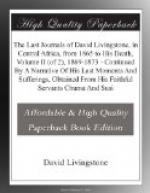17th April, 1873.—A tremendous rain after dark burst all our now rotten tents to shreds. Went on at 6.35 A.M. for three hours, and I, who was suffering severely all night, had to rest. We got water near the surface by digging in yellow sand. Three hills now appear in the distance. Our course, S.W. three and three-quarter hours to a village on the Kazya River. A Nyassa man declared that his father had brought the heavy rain of the 16th on us. We crossed three sponges.
18th April, 1873.—On leaving the village on the Kazya, we forded it and found it seventy yards broad, waist to breast deep all over. A large weir spanned it, and we went on the lower side of that. Much papyrus and other aquatic plants in it. Fish are returning now with the falling waters, and are guided into the rush-cones set for them. Crossed two large sponges, and I was forced to stop at a village after travelling S.W. for two hours: very ill all night, but remembered that the bleeding and most other ailments in this land are forms of fever. Took two scruple doses of quinine, and stopped it quite.
19th April, 1873.—A fine bracing S.E. breeze kept me on the donkey across a broad sponge and over flats of white sandy soil and much cultivation for an hour and a half, when we stopped at a large village on the right bank of,[32] and men went over to the chief Muanzambamba to ask canoes to cross to-morrow. I am excessively weak, and but for the donkey could not move a hundred yards. It is not all pleasure this exploration. The Lavusi hills are a relief tothe eye in this flat upland. Their forms show an igneous origin. The river Kazya comes from them and goes direct into the Lake. No observations now, owing to great weakness; I can scarcely hold the pencil, and my stick is a burden. Tent gone; the men build a good hut for me and the luggage. S.W. one and a half hour.
20th April, 1873, Sunday.—Service. Cross over the sponge, Moenda, for food and to be near the headman of these parts, Moanzambamba. I am excessively weak. Village on Moenda sponge, 7 A.M. Cross Lokulu in a canoe. The river is about thirty yards broad, very deep, and flowing in marshes two knots from S.S.B. to N.N.W. into Lake.
FOOTNOTES:
[28] It will be observed that these islets were in reality slight eminences standing above water on the flooded plains which border on Lake Bangweolo. The men say that the actual deep-water Lake lay away to their right, and on being asked why Dr. Livingstone did not make a short cut across to the southern shore, they explain that the canoes could not live for an hour on the Lake, but were merely suited for punting about over the flooded land.—Ed.
[29] Defoe’s book, ‘Adventures of Captain Singleton,’ is alluded to. It would almost appear as if Defoe must have come across some unknown African traveller who gave him materials for this work.—Ed.




